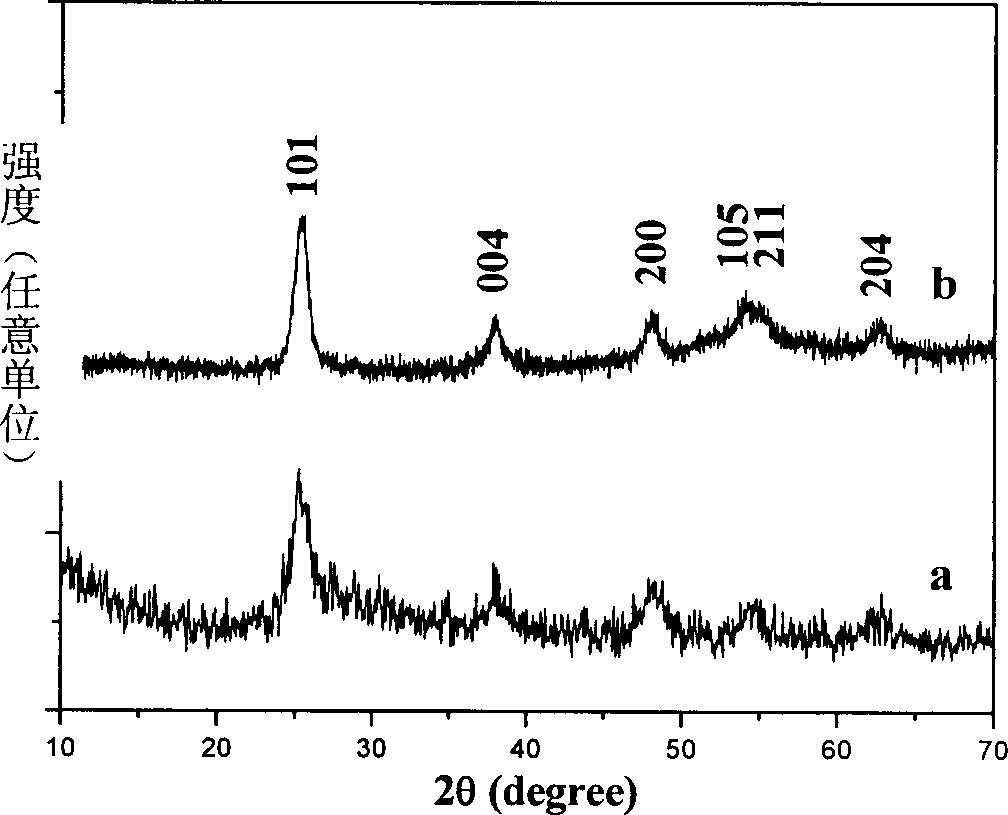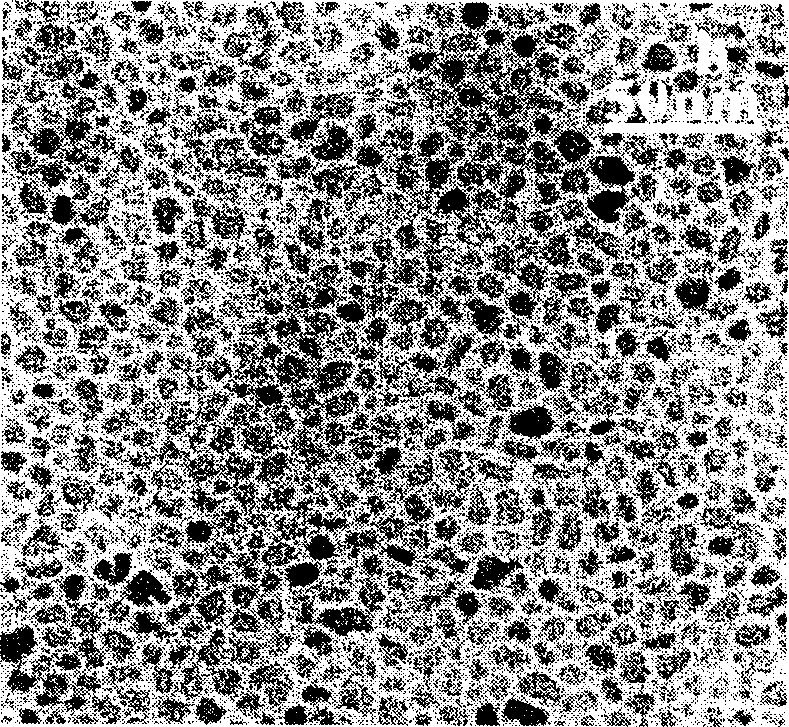Synthesis of TiO2 nanometer particles and bars
A synthesis method and nanoparticle technology, applied in the direction of titanium dioxide, titanium oxide/hydroxide, etc., can solve the problems of difficulty in obtaining high crystallinity, uniform size, inability to further assemble, industrial application limitations, etc. The effect of cheap raw materials and stable product quality
- Summary
- Abstract
- Description
- Claims
- Application Information
AI Technical Summary
Problems solved by technology
Method used
Image
Examples
Embodiment 1
[0031] In typical TiO 2 During the synthesis of nanoparticles, the NH 4 HCO 3 (1g), linoleic acid (LA, about 25mL), triethylamine (5mL) and cyclohexane (5mL) were mixed uniformly with electromagnetic stirring at room temperature, and then the Ti(OBu) 4 (1 mL) was slowly added dropwise to the solution. Stir further at room temperature to make the system evenly mixed, then transfer the solution to a stainless steel hydrothermal kettle with a Teflon (Teflon) liner and react for several hours at 150°C to obtain high crystallinity, uniform size, and organic solvent redispersible TiO 2 nanoparticles.
[0032] In typical TiO 2 During the synthesis of nanorods, linoleic acid (LA, about 7mL), triethylamine (5mL) and cyclohexane (15mL) were mixed uniformly with electromagnetic stirring at room temperature, and the Ti(OBu) 4 (1 mL) was slowly added dropwise to the solution. At room temperature, electromagnetically stir further to make the system evenly mixed, then transfer the solut...
Embodiment 2
[0035] In typical TiO 2 During the synthesis of nanoparticles, the NH 4 HCO 3 (0.5g), linoleic acid (LA, about 10mL), triethylamine (1mL) and cyclohexane (10mL) were mixed uniformly with electromagnetic stirring at room temperature. 2% SnCl 4 ·5H 2 O was added to the reaction system. Then Ti(OBu) 4 (2 mL) was slowly added dropwise to the solution. Stir further at room temperature to make the system evenly mixed, then transfer the solution to a stainless steel hydrothermal kettle with a Teflon (Teflon) liner and react at 180° C. for several hours. Under the same conditions, replace tetrabutyl titanate with organic titanates such as tetraisopropyl titanate, replace linoleic acid with long-chain organic acids such as dodecanoic acid and capric acid, and replace triethylamine with Replaced with organic amines such as dodecylamine, replaced cyclohexane with low-boiling organic solvents such as hexane, controlled the reaction temperature at 100, 150, and 200°C, and controlled...
Embodiment 3
[0037] In typical TiO 2 During the synthesis of nanoparticles, the NH 4 HCO 3 (2 g), linoleic acid (LA, about 5 mL), triethylamine (3 mL) and cyclohexane (5 mL) were mixed uniformly at room temperature with electromagnetic stirring. 1% FeCl 3 added to the reaction system. Then Ti(OBu) 4 (5mL) was slowly added dropwise to the solution. Stir further at room temperature to make the system evenly mixed, and then transfer the solution to a stainless steel hydrothermal kettle with a Teflon liner and react at 100°C for several hours.
[0038] Under the same conditions, replace tetrabutyl titanate with organic titanates such as tetraisopropyl titanate, replace linoleic acid with long-chain organic acids such as dodecanoic acid and capric acid, and replace triethylamine with Replaced with organic amines such as dodecylamine, replaced cyclohexane with low-boiling organic solvents such as hexane, controlled the reaction temperature at 100, 150, and 200°C, and controlled the amount ...
PUM
 Login to View More
Login to View More Abstract
Description
Claims
Application Information
 Login to View More
Login to View More - R&D Engineer
- R&D Manager
- IP Professional
- Industry Leading Data Capabilities
- Powerful AI technology
- Patent DNA Extraction
Browse by: Latest US Patents, China's latest patents, Technical Efficacy Thesaurus, Application Domain, Technology Topic, Popular Technical Reports.
© 2024 PatSnap. All rights reserved.Legal|Privacy policy|Modern Slavery Act Transparency Statement|Sitemap|About US| Contact US: help@patsnap.com










